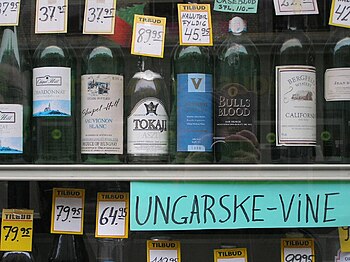 |
| Chianti Classico Riserva fromVolpaia (Photo credit: Wikipedia) |
Less experienced consumers tend to believe that a DOCG 'Chianti' wine and a DOCG 'Chinati Classico' wine are the same things.
Nothing more wrong than that!
Chianti Classico is a wine produced in the Chianti area. You may recognize these wines very easily by the 'black rooster' logo on the neck of the bottles.
The 'Chianti Classico Consortium' applies much stricter rules to its producers in comparison to those applied to the producers of 'Chianti'. Let us analyze these differences.
Production area: the Chianti Classico wine is produced within the borders of the namesake area only, whereas Chianti producers can implement their production also outside those borders, including some areas of the Tuscan provinces of Florence, Siena, Arezzo, Pisa, Pistoia, and Prato.
Grapes: While the Chianti Classico uses black grapes only with a minimum basis of 80% of Sangiovese (the typical grape of the Chianti's area) the Chianti wine can use also white grapes such as Malvasia and Trebbiano (in addition to the minimum basis of Sangiovese which is 75% in this case).
Quality standard: without going through the details, it is important to know that the rules of the Chianti Classico Consortium are much more rigid and strict on all the aspects which can have an impact on wine's quality. For example, the 'resa Massima di uva per ettaro di vigneto' (the maximum amount of grapes for hectare) is 75 quintals for Chianti Classico, while for Chianti the limit gets to 90 quintals.
The first version of the DOCG 'disciplinare' (production rules) for Chianti and Chianti Classico dates back to 1984 when Chianti Classico was still considered a sub-category of the Omni-comprehensive Chianti DOCG, although with separate regulations that imposed production rules more stringent than those stipulated for the other Chianti wines. Only in 1996 Chianti Classico obtained the definitive consecration of its importance and its precedence: Chianti Classico, in fact, was recognized as an independent appellation, establishing once and for all its diversity and independence of the other Chiantis.
Chianti and Chianti Classico are not the only traditional wine made in Tuscany, and sangiovese is usually the base of most red variants like Vino Nobile di Montepulciano, Morellino di Scansano, Brunello di Montalcino, Rosso di Montalcino, etc.
A black rooster was the emblem of the Lega del Chianti during the XVII century. Now 2005 the black rooster is the emblem of the Chianti Classico producers association, all Chianti Classico wines have that symbol on the neck of the bottle indicating that the wine is produced in the Classico area and according to the Chianti Classico Consortium rules.
In summary, especially in the last years, Chianti Classico Consortium's policy is to safeguard wine's quality to the detriment of quantity, mainly because of the growing number of high-quality wine all over the world. Furthermore, there is another aim which is to safeguard the quality aspects specific to the area making the Gallo Nero products unique. In that matter, on top of the Chianti Classico wine, the Vin Santo and the Olive Oil should also be mentioned.










